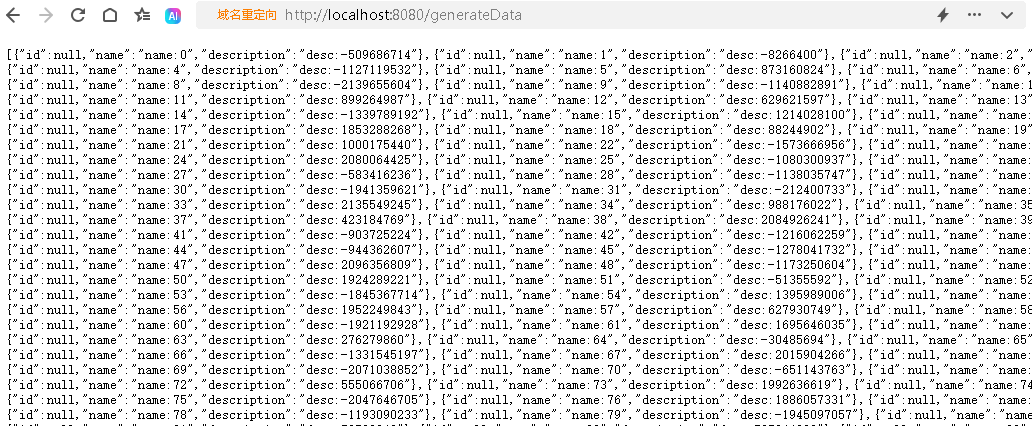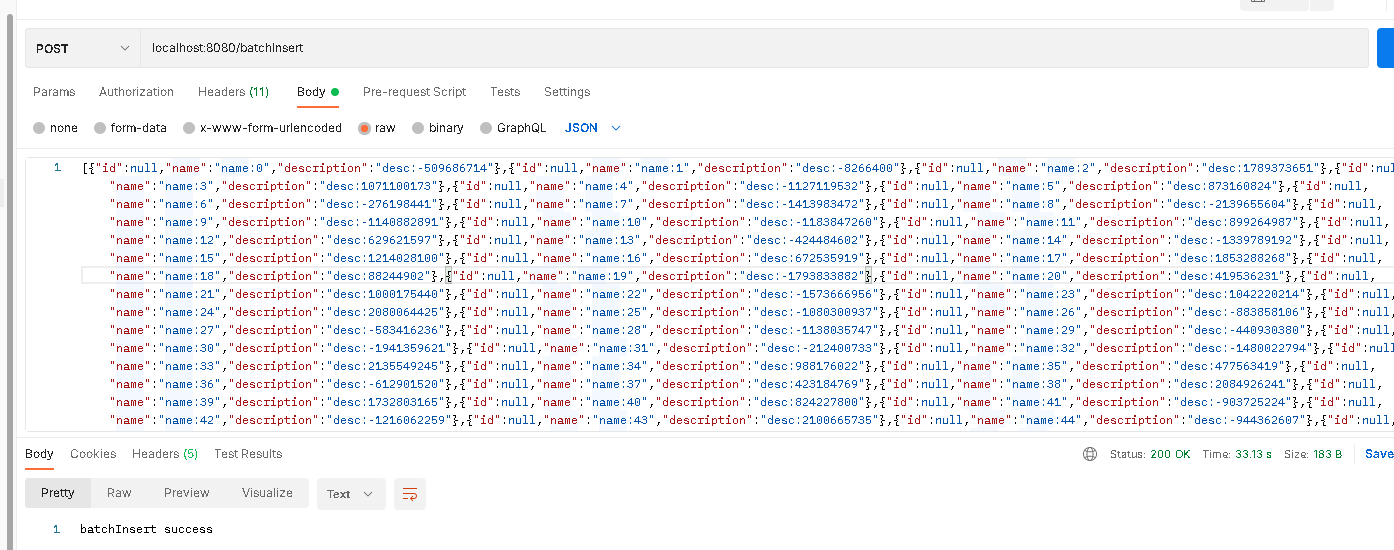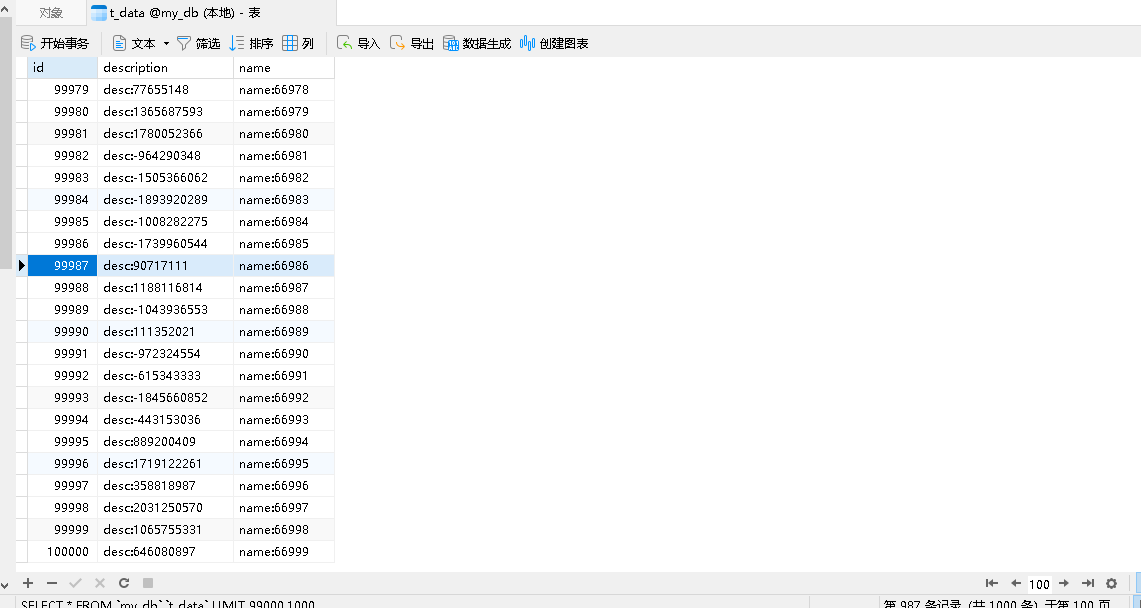一、前言
在当今数字化高速发展的时代,数据规模呈现爆炸式增长的态势。无论是电子商务平台的海量交易记录,社交媒体中的海量用户动态,还是企业级应用中的复杂业务数据,其数量都极为庞大。在这样的背景下,如何高效地处理和存储海量数据成为应用开发中至关重要的挑战。
Spring Boot 作为强大且成熟的开发框架,为构建稳定可靠的应用奠定了坚实基础。SpringData JPA 在数据操作方面提供了便捷高效的途径。而 ThreadPoolTaskExecutor 能够充分发挥多核 CPU 的优势,借助并发处理大幅提升数据插入的速度。
通过将这三者有机结合,我们能够构建一个快速、稳定且能够处理百万级数据批量插入的系统,满足业务对于数据处理的高性能和高可靠性要求。这不仅能够显著提升系统的整体性能,还能为用户带来更为流畅的使用体验,增强系统在激烈市场竞争中的核心竞争力。
二、示例项目
1.创建项目,添加依赖
<?xml version="1.0" encoding="UTF-8"?>
<project xmlns="http://maven.apache.org/POM/4.0.0" xmlns:xsi="http://www.w3.org/2001/XMLSchema-instance"
xsi:schemaLocation="http://maven.apache.org/POM/4.0.0 https://maven.apache.org/xsd/maven-4.0.0.xsd">
<modelVersion>4.0.0</modelVersion>
<parent>
<groupId>org.springframework.boot</groupId>
<artifactId>spring-boot-starter-parent</artifactId>
<version>2.7.17</version>
<relativePath/> <!-- lookup parent from repository -->
</parent>
<groupId>com.example</groupId>
<artifactId>DataProject</artifactId>
<version>0.0.1-SNAPSHOT</version>
<name>DataProject</name>
<description>DataProject</description>
<url/>
<licenses>
<license/>
</licenses>
<developers>
<developer/>
</developers>
<scm>
<connection/>
<developerConnection/>
<tag/>
<url/>
</scm>
<properties>
<java.version>1.8</java.version>
</properties>
<dependencies>
<dependency>
<groupId>org.springframework.boot</groupId>
<artifactId>spring-boot-starter-web</artifactId>
</dependency>
<dependency>
<groupId>mysql</groupId>
<artifactId>mysql-connector-java</artifactId>
<version>8.0.31</version>
</dependency>
<dependency>
<groupId>org.springframework.boot</groupId>
<artifactId>spring-boot-starter-data-jpa</artifactId>
</dependency>
<dependency>
<groupId>org.projectlombok</groupId>
<artifactId>lombok</artifactId>
</dependency>
<dependency>
<groupId>org.springframework.boot</groupId>
<artifactId>spring-boot-starter-test</artifactId>
<scope>test</scope>
</dependency>
</dependencies>
<build>
<plugins>
<plugin>
<groupId>org.springframework.boot</groupId>
<artifactId>spring-boot-maven-plugin</artifactId>
</plugin>
</plugins>
</build>
</project>
- 1.
- 2.
- 3.
- 4.
- 5.
- 6.
- 7.
- 8.
- 9.
- 10.
- 11.
- 12.
- 13.
- 14.
- 15.
- 16.
- 17.
- 18.
- 19.
- 20.
- 21.
- 22.
- 23.
- 24.
- 25.
- 26.
- 27.
- 28.
- 29.
- 30.
- 31.
- 32.
- 33.
- 34.
- 35.
- 36.
- 37.
- 38.
- 39.
- 40.
- 41.
- 42.
- 43.
- 44.
- 45.
- 46.
- 47.
- 48.
- 49.
- 50.
- 51.
- 52.
- 53.
- 54.
- 55.
- 56.
- 57.
- 58.
- 59.
- 60.
- 61.
- 62.
- 63.
- 64.
- 65.
- 66.
2.添加项目配置
#数据库配置
spring.datasource.driver-class-name=com.mysql.cj.jdbc.Driver
spring.datasource.username=root
spring.datasource.password=123456
spring.datasource.url=jdbc:mysql://localhost:3306/my_db?useUnicode=true&characterEncoding=UTF-8&useSSL=false
#线程池配置
spring.task.executor.core-pool-size=100
spring.task.executor.max-pool-size=300
spring.task.executor.queue-capacity=99999
#jpa配置
spring.jpa.hibernate.ddl-auto=update
spring.jpa.show-sql=true
spring.datasource.hikari.maximum-pool-size=100
spring.datasource.hikari.connection-timeout=6000- 1.
- 2.
- 3.
- 4.
- 5.
- 6.
- 7.
- 8.
- 9.
- 10.
- 11.
- 12.
- 13.
- 14.
3.创建实体类
package com.example.dataproject.entity;
import lombok.Getter;
import lombok.Setter;
import javax.persistence.*;
/**
* @author qx
* @date 2024/8/1
* @des 测试实体
*/
@Entity
@Table(name = "t_data")
@Getter
@Setter
public class MyData {
@Id
@GeneratedValue(strategy = GenerationType.IDENTITY)
private Long id;
private String name;
private String description;
}- 1.
- 2.
- 3.
- 4.
- 5.
- 6.
- 7.
- 8.
- 9.
- 10.
- 11.
- 12.
- 13.
- 14.
- 15.
- 16.
- 17.
- 18.
- 19.
- 20.
- 21.
- 22.
- 23.
- 24.
- 25.
- 26.
- 27.
4.数据持久层
5.服务层
package com.example.dataproject.service;
import com.example.dataproject.dao.MyDataDao;
import com.example.dataproject.entity.MyData;
import org.springframework.beans.factory.annotation.Autowired;
import org.springframework.scheduling.concurrent.ThreadPoolTaskExecutor;
import org.springframework.stereotype.Service;
import java.util.ArrayList;
import java.util.List;
import java.util.concurrent.Callable;
import java.util.concurrent.ExecutionException;
import java.util.concurrent.Future;
import java.util.concurrent.ThreadPoolExecutor;
/**
* @author qx
* @date 2024/8/1
* @des 服务层
*/
@Service
public class MyDataService {
@Autowired
private ThreadPoolTaskExecutor taskExecutor;
@Autowired
private MyDataDao myDataDao;
public void batchInsertData(List<MyData> dataList) {
//每次插入的数量
int batchSize = 1000;
List<Future<?>> futures = new ArrayList<>();
for (int i = 0; i < dataList.size(); i += batchSize) {
List<MyData> subList = dataList.subList(i, Math.min(i + batchSize, dataList.size()));
futures.add(taskExecutor.submit((Callable<Void>) () -> {
myDataDao.saveAll(subList);
return null;
}));
}
for (Future<?> future : futures) {
try {
future.get();
} catch (InterruptedException | ExecutionException e) {
throw new RuntimeException(e);
}
}
}
}
- 1.
- 2.
- 3.
- 4.
- 5.
- 6.
- 7.
- 8.
- 9.
- 10.
- 11.
- 12.
- 13.
- 14.
- 15.
- 16.
- 17.
- 18.
- 19.
- 20.
- 21.
- 22.
- 23.
- 24.
- 25.
- 26.
- 27.
- 28.
- 29.
- 30.
- 31.
- 32.
- 33.
- 34.
- 35.
- 36.
- 37.
- 38.
- 39.
- 40.
- 41.
- 42.
- 43.
- 44.
- 45.
- 46.
- 47.
- 48.
6.线程池配置
package com.example.dataproject.config;
import org.springframework.beans.factory.annotation.Value;
import org.springframework.context.annotation.Bean;
import org.springframework.context.annotation.Configuration;
import org.springframework.scheduling.concurrent.ThreadPoolTaskExecutor;
/**
* @author qx
* @date 2024/8/1
* @des 线程池配置类
*/
@Configuration
public class ExecutorConfig {
@Value("${spring.task.executor.core-pool-size}")
private int corePoolSize;
@Value("${spring.task.executor.max-pool-size}")
private int maxPoolSize;
@Value("${spring.task.executor.queue-capacity}")
private int queueCapacity;
@Bean
public ThreadPoolTaskExecutor taskExecutor() {
ThreadPoolTaskExecutor executor = new ThreadPoolTaskExecutor();
executor.setCorePoolSize(corePoolSize);
executor.setMaxPoolSize(maxPoolSize);
executor.setQueueCapacity(queueCapacity);
return executor;
}
}
- 1.
- 2.
- 3.
- 4.
- 5.
- 6.
- 7.
- 8.
- 9.
- 10.
- 11.
- 12.
- 13.
- 14.
- 15.
- 16.
- 17.
- 18.
- 19.
- 20.
- 21.
- 22.
- 23.
- 24.
- 25.
- 26.
- 27.
- 28.
- 29.
- 30.
- 31.
- 32.
- 33.
7.创建控制层
package com.example.dataproject.controller;
import com.example.dataproject.entity.MyData;
import com.example.dataproject.service.MyDataService;
import org.springframework.beans.factory.annotation.Autowired;
import org.springframework.web.bind.annotation.GetMapping;
import org.springframework.web.bind.annotation.PostMapping;
import org.springframework.web.bind.annotation.RequestBody;
import org.springframework.web.bind.annotation.RestController;
import java.util.ArrayList;
import java.util.List;
import java.util.Random;
/**
* @author qx
* @date 2024/8/1
* @des 控制层
*/
@RestController
public class MyDataController {
@Autowired
private MyDataService myDataService;
/**
* 批量插入数据
*/
@PostMapping("/batchInsert")
public String batchInsertData(@RequestBody List<MyData> dataList) {
myDataService.batchInsertData(dataList);
return "batchInsert success";
}
/**
* 生成数据
*/
@GetMapping("/generateData")
public List<MyData> generateData() {
List<MyData> dataList = new ArrayList<>();
Random random = new Random();
MyData myData;
for (int i = 0; i < 1000000; i++) {
myData = new MyData();
myData.setName("name:" + i);
myData.setDescription("desc:" + random.nextInt());
dataList.add(myData);
}
return dataList;
}
}
- 1.
- 2.
- 3.
- 4.
- 5.
- 6.
- 7.
- 8.
- 9.
- 10.
- 11.
- 12.
- 13.
- 14.
- 15.
- 16.
- 17.
- 18.
- 19.
- 20.
- 21.
- 22.
- 23.
- 24.
- 25.
- 26.
- 27.
- 28.
- 29.
- 30.
- 31.
- 32.
- 33.
- 34.
- 35.
- 36.
- 37.
- 38.
- 39.
- 40.
- 41.
- 42.
- 43.
- 44.
- 45.
- 46.
- 47.
- 48.
- 49.
- 50.
- 51.
- 52.
8.启动项目进行测试
我们先生成需要插入的数据。

然后在postman中进行数据的批量插入。

点击send进行批量插入测试。

我们查看数据库发现批量数据添加成功。






















 379
379

 被折叠的 条评论
为什么被折叠?
被折叠的 条评论
为什么被折叠?








